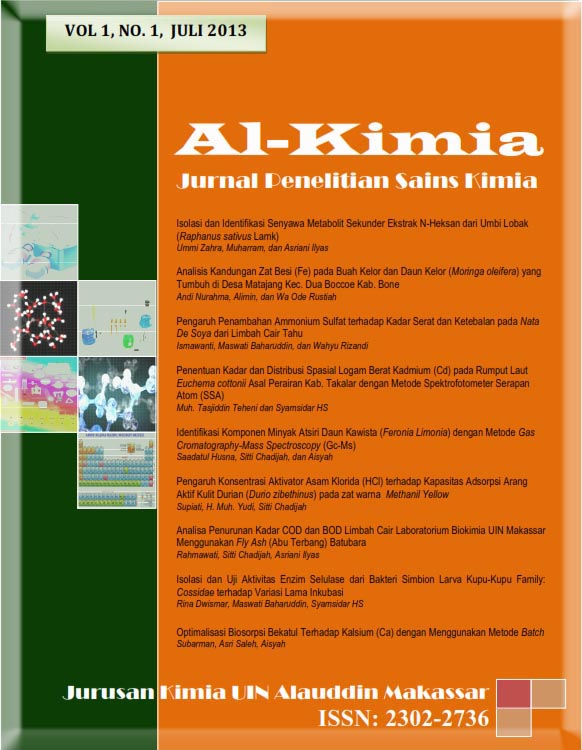Analisis Kandungan Zat Besi (Fe) Pada Buah Kelor dan Daun Kelor (Moringa Oleifera) yang Tumbuh di Desa Matajang Kec. Dua Boccoe Kab. Bone
Abstrak
This research is a kind of experiment research by analyze mineral such as iron essence (Fe) that are needed as a suplement in our body. In this research are used the kelor’s fruits and kelor’s leaf as specimen with the aim to know the iron essence (Fe) that content in the specimen. The content of iron essence (Fe) in specimen are used by Atomic Absorption Spectroscopy (AAS) method. The kelor’s fruits, the average iron essence (Fe) content in A place is 2,50 mg/100 gram specimen, B place is 3,20 mg/100 gram specimen, C place si 3,59 mg/100 gram specimen and D place is 4,51 mg/100 gram specimen. Than the kelor’s leaf, the average iron essence (Fe) content in A place is 5,89 mg/100 gram specimen, B place 5,73 mg/100 gram specimen, C place is 6,02 mg/100 gram specimen and D place is 6,21 mg/100 gram specimen.
##plugins.generic.usageStats.downloads##
Referensi
Ismail, 2006, Fisiologi Tumbuhan. Makassar: FMIPA UNM.
Poerwowidodo, 1992, Telaah Kesuburan Tanah. Bandung: Angkasa.
Rahmawati Abbas, Veni Hadju, dan Burhanuddin Bahar, 2009, Asupan Zat Gizi pada Remaja Usia 10-14 Tahun Di Pulau Barrang Lompo Makassar Tahun 2003, Http://jurnalmkmi.blogspot.com/2009/03/asupan-zat-besi-pada-remajaputri-usia.html, 22 Desember 2009.
Ramli, 2007, Analisis Kadar Kalsium (Ca) dan Besi (Fe) Pada Bawang Merah yang Beredar di Pasaran Secara Spektroskopis Serapan Atom, Skripsi. Makassar: FMIPA UNM Makassar.
Untung Suwahyono, 2008, Mengupas Rahasia Tersembunyi Pohon Kelor. Yogyakarta: Lili Publisher.
Wahyu Widowati, Astiana Sastiono dan Rymond Jusuf Rumampuk, 2008, Efek Toksik Logam Pencegahan dan Penanggulanngannya. Yogyakarta: CV. Andi Offset.
Winarno, F. G., 2004, Kimia Pangan Dan Gizi. Jakarta: PT Gramedia Pustaka Utama.
Authors who publish with this journal agree to the following terms:
1) Authors retain copyright and grant the journal right of first publication with the work simultaneously licensed under a Creative Commons Attribution License that allows others to share the work with an acknowledgement of the work's authorship and initial publication in this journal.
2) Authors are able to enter into separate, additional contractual arrangements for the non-exclusive distribution of the journal's published version of the work (e.g., post it to an institutional repository or publish it in a book), with an acknowledgement of its initial publication in this journal.
3)Authors are permitted and encouraged to post their work online (e.g., in institutional repositories or on their website) prior to and during the submission process, as it can lead to productive exchanges, as well as earlier and greater citation of published work (See The Effect of Open Access).


